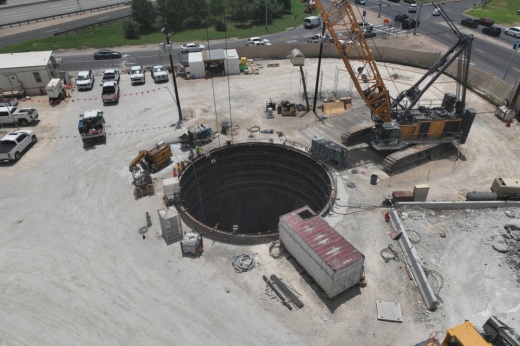Explained
As part of the I-35 overhaul in Central Austin, which will lower sections of the highway below ground level, the transportation agency will build underground drainage tunnels to help prevent flooding along the corridor.
Plans show the tunnels—large enough to fit a standard Capital Metro bus—would extend along I-35 from 45th Street down to Cesar Chavez Street, then veer east on Cesar Chavez and end near US 183 by Lady Bird Lake.
Boring crews will drill nine drop shafts along the proposed tunnel route in phases, beginning with excavation near Airport Boulevard, 15th Street, Brushy Street, River Street and Cesar Chavez Street. The first tunnel boring machine will be deployed near Airport Boulevard in 2026, according to a TxDOT spokesperson.
Once the drop shafts are completed—ranging from 70 to 200 feet in depth—two boring machines, manufactured by Germany-based Herrenknecht, will begin cutting tunnels between each shaft.
The project will also see the construction of a new pump station, which will treat up to 130,000 gallons of runoff water per minute before discharging into the Colorado River, TxDOT documents state.
The drainage tunnel and pump station project is designed to improve water quality and reduce flooding east of I-35. The system will filter out trash and sediment, lessen runoff into the Boggy Creek and Waller Creek watershed.
The project is also expected to lower the surrounding floodplain by roughly 350 acres—helping ease strain on the existing Waller Creek tunnel, according to TxDOT documents.
Contractor Sak & Shea will oversee the $748 million project, which is being funded by TxDOT and federal dollars obtained by the Capital Area Metropolitan Planning Organization.

Construction work will be done around the clock, to reduce length and traffic impacts, TxDOT documents state. Industry experts say tunnel boring machines typically advance about 50 feet per day.
Drilling, excavation and debris removal are expected to generate increased dust. To reduce this, crews will use a “sprinkling” process—deploying a street sweeper equipped with a water tank—to keep the project site clean and limit dust in the area.
Nearby residents may also feel some vibration during parts of the project, particularly when crews are excavating drop shafts and tunneling underground. The strength of vibrations will depend on how close an individual is to the worksite. These activities are expected to last several months for each site. The entire project completion is estimated for 2029.
“TxDOT and the contractor will provide on-going monitoring during construction and will halt activities if unsafe levels are detected,” a TxDOT spokesperson said in a statement.
To minimize impacts, TxDOT will offer property surveys before and after construction for buildings within 100 feet of a drop shaft, agency documents state.
Additionally, crews will install geothermal monitoring equipment that continuously monitors vibration levels. Work will be paused if vibrations reach unsafe levels until additional safety measures are in place.
Temporary sound walls have been erected to help mitigate noise from drilling, generators, ventilation fans and trucks.






